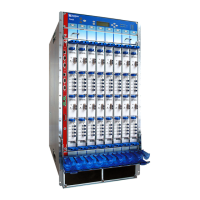Removing a T640 SFP
Small form-factor pluggables (SFPs) are transceivers that can be removed from a PIC.
SFPs are hot-insertable and hot-removable. Removing an SFP does not interrupt PIC
functioning, but the removed SFP no longer receives or transmits data.
NOTE: When you remove a PIC transceiver, the router continues to function,
although the PIC interface being removed no longer functions.
Figure 226: Small Form-Factor Pluggable (SFP)
g001855
Connector
Locking pin
NOTE: This procedure applies to both SFP and SFP+ transceivers.
To remove an SFP transceiver (see Figure 226 on page 422):
1. Place an electrostatic bag or antistatic mat on a flat, stable surface to receive the
SFP. Have ready a rubber safety cap for the SFP transceiver and the cable.
2. Attach an electrostatic discharge (ESD) grounding strap to your bare wrist, and connect
the strap to one of the ESD points on the chassis.
3. Label the cable connected to the SFP so that you can later reconnect it to the correct
SFP.
4. Disconnect the cable from the SFP. Immediately cover the transceiver and the end
of the cable with a rubber safety cap.
WARNING: Do not look directly into a fiber-optic transceiver or into the
ends of fiber-optic cables. Fiber-optic transceivers and fiber-optic cable
connected to a transceiver emit laser light that can damage your eyes.
CAUTION: Do not leave a fiber-optic transceiver uncovered except when
inserting or removing cable. The safety cap keeps the port clean and
prevents accidental exposure to laser light.
Copyright © 2017, Juniper Networks, Inc.422
T640 Core Router Hardware Guide

